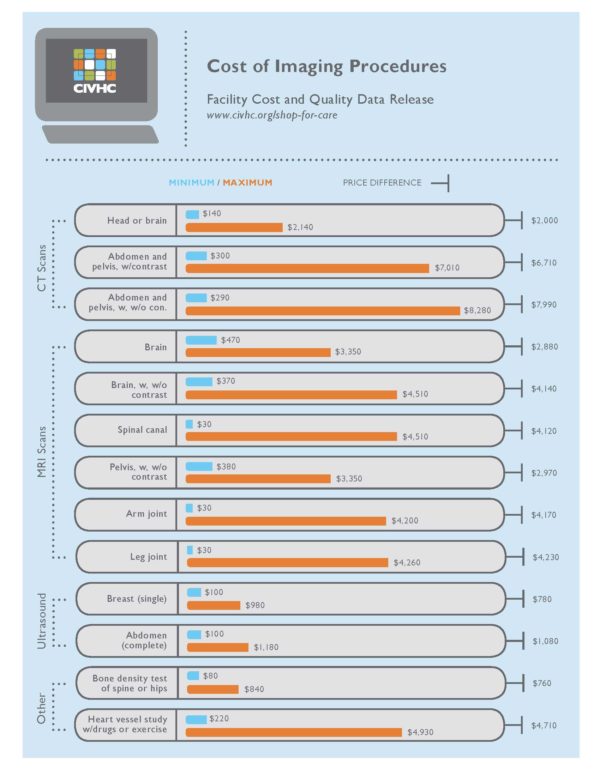Colorado Has a New Tool to Compare Hospital Costs
 Imagine you have a swollen knee, and your doctor suggests that you need a MRI scan.
Imagine you have a swollen knee, and your doctor suggests that you need a MRI scan.
Depending on where in Colorado you go for care, that MRI could cost $30 – or $4,260.
Or perhaps you need a CT scan of your abdomen and pelvis. That CT scan could cost you $290 – or $8,280. That’s a $7,990 difference, depending on which hospital you visit.
Those estimates come from a new resource released this week by the Center for Improving Value in Health Care, or CIVHC, a nonprofit that tracks much of the state’s health care spending through Colorado's All Payers Claims Database.
The “Shop for Care” tool lets consumers check average prices for 13 different imaging services. Click on a procedure and a region, and a list of hospitals and price ranges appears. The prices are based on how much patients and commercial insurers paid for those procedures in 2016. You’ll also see how patients rank the quality of care at each facility.
The CIVHC online tool is a step towards illuminating differences in health care costs. But even so, it is still difficult and complicated to make informed decisions about care and costs.
Takeaways
A few takeaways from the data:
- There are huge gaps in how much people and insurers pay for the same procedures. Those differences range from a $780 gap between the most and least expensive breast ultrasound to a $7,990 gap between the most and least expensive stomach CT scan.
- The same hospital can charge wildly different fees for the same procedure. The website reveals the average cost each hospital charges, but it also shows price ranges – and sometimes those ranges are bigger than the differences between hospitals. Colorado Plains Medical Center, for instance, charged anywhere from $470 to $8,310 for a stomach CT scan. That’s likely because hospitals’ insurance contracts can vary. But those huge ranges mean it’s hard to predict through Shop for Care just how much you and your insurer will be charged for a given service.
- Price and quality DON’T always go hand in hand. An $1,830 MRI scan of an arm at Centura Health St. Thomas More Hospital in Cañon City gets three stars for patient satisfaction, while a $620 scan at UCHealth Yampa Valley Medical Center in Steamboat Springs gets five stars. More expensive care is not always better, according to this data.
- Rural hospitals often charge more for care. For instance, a head CT scan costs $2,140 at Valley View Hospital in Glenwood Springs but just $140 at UCHealth Poudre Valley hospital in Fort Collins. (That’s no surprise. CHI’s Edmond Toy has written about the issue of high costs in rural areas and what may be driving those costs.)
- The tool doesn’t show what you’ll actually pay. CIVHC provides clear information on what the website does and doesn’t show, and it recommends that people contact hospitals and insurance companies for more specific price information. But it’s still worth noting that patients will likely have to do a lot more research if they want to figure out how much they will really pay. Why?
- The prices listed don’t include physician fees, which can add hundreds of dollars and sometimes catch consumers by surprise when doctors are not in their insurers’ network.
- The prices are a composite of what patients and insurers pay, so it doesn’t show patients their actual out-of-pocket costs.
- Even for patients paying entirely out-of-pocket, the big price ranges can make it hard to pin down what they’ll pay.
- Patients may not act on price differences — either because they can’t or because they have little incentive to. Patients who live close to one hospital might find that other options are too far away, even if the procedure is less expensive. Or a hospital that shows up as less expensive may not take the patient’s insurance. Other patients may not be interested in getting care in an unfamiliar setting. Meanwhile, people who have met their deductibles for health insurance may not have a strong incentive to seek out the most efficient care, since the cost will be covered by the insurer.
On the other hand, a spokeswoman for CIVHC said the organization often gets requests from people looking to figure out how much different procedures cost — a sign that some patients are serious about comparison shopping.
"Providing Patients with Actionable Data"
In a press release, Ana English, CIVHC’s president and CEO, said that “in this digital age, health care is one of the few markets where consumers don’t always have the information they need to make smart purchasing decisions. Our goal is to change that by providing patients with actionable data to help them make informed decisions about where they go for care.”
This is the first searchable database of the costs for services released by CIVHC in several years. The organization previously published information on the cost of hip replacements, knee replacements, vaginal deliveries, and cesarean births at various hospitals using claims from 2012; those data are currently available in PDF form. In the coming months, the organization plans to release more searchable and up-to-date data on those and other common services.
There’s no guarantee that more transparency means that facilitieswill lower costs. Still, the new tool spotlights the vast differences in what people pay for the same procedures. It might help providers and insurers put the costs they’ve been charging or paying in context. And it might be a start for patients trying to find more affordable choices that are still high quality – which is no small feat at a time when one in five Coloradans say they’re skipping care because it costs too much.
The Colorado All Payers Claims Database that informs all of these resources is an example of how legislators have acted to help people understand and — ideally — control the cost of health care. It was created by a 2010 law that aimed to “result in usable and comparable information” that allows various stakeholders to understand the costs of health plans, services, and more. In 2018, on the other hand, efforts to push for even more transparency in health care costs didn’t make it very far in the legislature.
But the cost of health care is still at the top of the minds of legislators and Coloradans, and we’re likely to see more legislation related to transparency in coming years — as well as more efforts from CIVHC and other organizations to help inform policymakers and consumers.
Related stories:
- 2018 Legislation in Review
- New approaches to paying for health care: Implications for quality improvement and cost containment in Colorado
- Transparency in Health Care – Colorado’s new tool
- Screening for Hepatitis C climbs in Colorado

